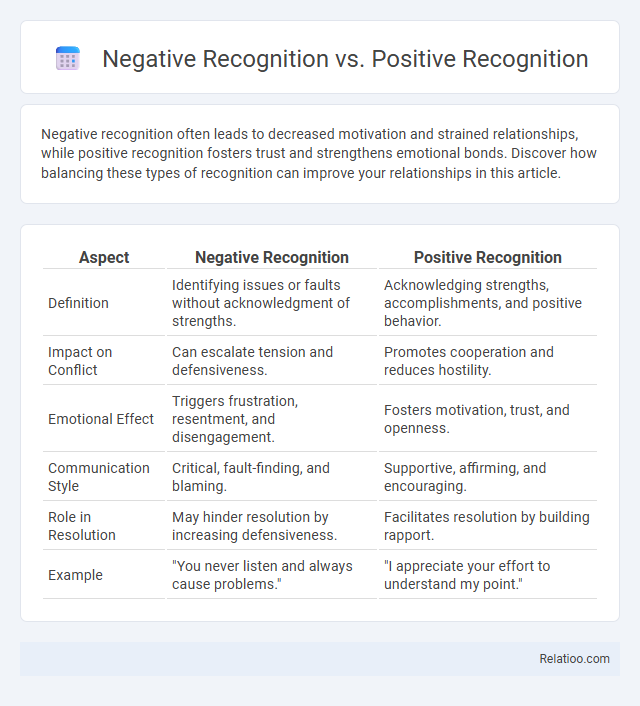Negative recognition often leads to decreased motivation and strained relationships, while positive recognition fosters trust and strengthens emotional bonds. Discover how balancing these types of recognition can improve your relationships in this article.
Table of Comparison
| Aspect | Negative Recognition | Positive Recognition |
|---|---|---|
| Definition | Identifying issues or faults without acknowledgment of strengths. | Acknowledging strengths, accomplishments, and positive behavior. |
| Impact on Conflict | Can escalate tension and defensiveness. | Promotes cooperation and reduces hostility. |
| Emotional Effect | Triggers frustration, resentment, and disengagement. | Fosters motivation, trust, and openness. |
| Communication Style | Critical, fault-finding, and blaming. | Supportive, affirming, and encouraging. |
| Role in Resolution | May hinder resolution by increasing defensiveness. | Facilitates resolution by building rapport. |
| Example | "You never listen and always cause problems." | "I appreciate your effort to understand my point." |
Understanding Recognition: Positive vs Negative
Recognition encompasses both positive and negative feedback, shaping individual motivation and behavior. Positive recognition reinforces desirable actions by rewarding achievements, while negative recognition highlights mistakes or shortcomings to encourage improvement. Understanding the balance between these types guides effective management strategies that foster growth and accountability.
The Psychology Behind Positive Recognition
Positive recognition in psychology leverages reinforcement theory by rewarding desirable behavior, thereby increasing motivation and self-esteem in individuals. Negative recognition, involving criticism or highlighting mistakes, can lead to stress and reduced engagement. Understanding how your brain responds to positive recognition can enhance productivity, making it a powerful tool for encouraging growth and fostering a supportive environment.
The Impact of Negative Recognition on Employees
Negative recognition negatively impacts employee motivation, leading to decreased productivity and increased stress levels. Your team's morale declines when efforts are criticized without constructive feedback, causing disengagement and higher turnover rates. Positive recognition, in contrast, fosters a culture of appreciation that enhances employee satisfaction and boosts overall organizational performance.
Comparing Outcomes: Motivation and Morale
Negative recognition, such as highlighting mistakes or failures, often diminishes motivation and lowers team morale by fostering fear or resentment. Positive recognition, which emphasizes achievements and strengths, typically enhances motivation, boosts self-esteem, and cultivates a supportive work environment. Your understanding of these dynamics can help create a balanced recognition strategy that maximizes both individual performance and overall morale.
Case Studies: Real-World Examples of Recognition Styles
Case studies reveal that positive recognition, such as employee awards at Google, enhances motivation and productivity by reinforcing desired behaviors, while negative recognition, exemplified by performance improvement plans at Amazon, may spur change but often damages morale and trust. Recognition that balances constructive feedback and genuine praise, as practiced at Microsoft, leads to sustained engagement and better team dynamics. Your choice of recognition style significantly impacts workplace culture and employee retention, making a strategic approach essential.
Best Practices for Implementing Positive Recognition
Positive recognition enhances employee morale and productivity by specifically acknowledging achievements and contributions, unlike general recognition which may be vague or inconsistent, and negative recognition that focuses on mistakes or shortcomings. Best practices for implementing positive recognition include providing timely, specific, and sincere praise that aligns with organizational values, fostering a culture of ongoing appreciation, and utilizing diverse methods such as verbal commendations, written notes, and public acknowledgments. Consistently applied positive recognition strategies improve employee engagement, reduce turnover, and reinforce desired behaviors within the workplace.
Consequences of Overusing Negative Recognition
Overusing negative recognition can lead to decreased employee motivation, increased workplace stress, and higher turnover rates, as constant criticism undermines self-esteem and job satisfaction. Positive recognition, in contrast, fosters engagement, boosts morale, and enhances productivity by reinforcing desirable behaviors and achievements. Balanced recognition strategies that emphasize constructive feedback alongside positive reinforcement create a healthier work environment and promote sustained organizational success.
Strategies to Shift from Negative to Positive Recognition
Negative recognition often centers on criticism and highlighting mistakes, which can erode morale and reduce motivation. Positive recognition strategies emphasize acknowledging achievements and reinforcing desired behaviors, leading to increased engagement and productivity. You can shift from negative to positive recognition by implementing consistent feedback mechanisms, celebrating small wins, and fostering a culture of appreciation that encourages continuous improvement and employee development.
Measuring the Effectiveness of Recognition Approaches
Measuring the effectiveness of negative recognition, positive recognition, and general recognition involves evaluating employee motivation, performance outcomes, and overall engagement levels. Positive recognition tends to increase job satisfaction and productivity by reinforcing desired behaviors, while negative recognition may lead to decreased morale and higher turnover rates. Utilizing metrics such as employee surveys, performance reviews, and retention statistics provides data-driven insights into which recognition approach most effectively drives organizational goals.
Building a Culture of Constructive Recognition
Negative recognition, often highlighting mistakes or shortcomings, can demoralize employees and hinder motivation, whereas positive recognition emphasizes achievements and strengths, fostering engagement and productivity. Recognition, when balanced and aligned with organizational goals, builds a culture of constructive recognition that encourages continuous improvement and reinforces desired behaviors. Implementing structured recognition programs that combine positive reinforcement with constructive feedback cultivates a supportive environment where employees feel valued and motivated.

Infographic: Negative Recognition vs Positive Recognition
 relatioo.com
relatioo.com